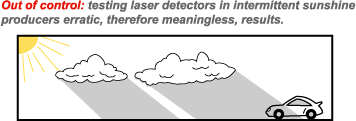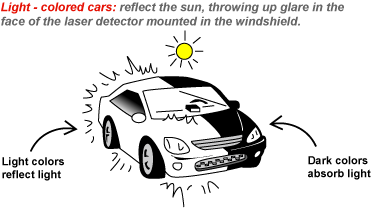Evaluating Laser Detector Tests
Speed laser amounts to shaft of faint light, very small in diameter, spaghetti size as it leaves the gun. A laser detector looks for that faint light. Laser enforcement is quick, and defending against a light beam is an iffy proposition. If the detector can’t find the light before the light finds its target—your car—warning will most likely be too late. But lasers, like other light, are reflected off various surfaces—posts and signs, other cars, the pavement. Moreover, the light gun is aimed by a human. His aim wobbles. At long ranges, he hits a lot of things beside his target. A good laser detector is sensitive enough to find these reflections, these aiming wobbles. Remember, though, that the bright section of the beam is only one-fifth of a degree wide, so testing laser detectors requires that the beam be positioned, and held in that position, with great precision.
Variables that must be controlled:
1. Ambient light
The brighter the sun, the harder it is to find a faint laser beam. Even the sun-to-shade-to-sun variations from passing clouds will make results non-repeatable.

As a potential customer, you’d like to know performance under the worst conditions—clear sky, high noon—and under the best conditions—dark of the night, after the sun’s glow has disappeared from the west.
2. Windshield glass
All glass absorbs some light, and different windshields use different glass formulations. So all testing should be done on the same car, maintaining the same position on the windshield for all detectors.

3. Car color
A hood painted white or silver reflects much more sunlight than a black one, to the detriment of laser detection. Again, all testing should be on the same car. Better yet, testing could compare the results of two cars, one white, one black, so you can see how reflections effect performance of each detector.
4. Aiming the laser beam
The laser gun must be securely mounted in order to produce a repeatable point of aim. Remember, the beam is very narrow compared to radar, practically a rifle shot.

This would be a revealing test: With the laser gun in a rigid fixture, aim the beam straight down the test lane at a spot on the pavement 500 to 800 feet from the gun. The exact same spot, and unvarying sun, are necessary to give each detector the same chance at detection. With each detector mounted in a repeatable position on a test car’s windshield, start well out of range and drive toward the laser gun. Which detectors find the reflected laser? How far off? Repeat test in bright sun and in dark of night.
Any detector that can find the reflection has a chance of providing useful warning. And the earlier the warning, the greater its usefulness.
Report 5: Radar Detectors Tests… If they don’t examine real customer needs, what’s the point?
